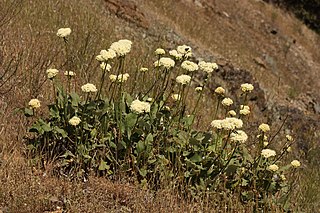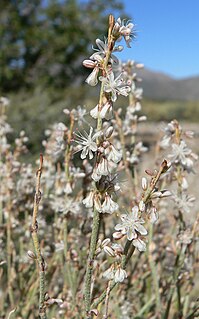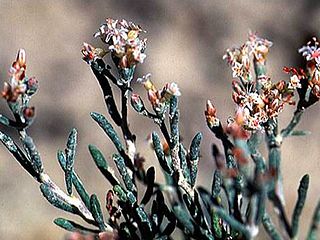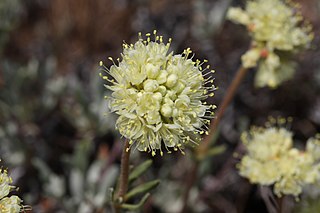
Eriogonum is a genus of flowering plants in the family Polygonaceae. The genus is found in North America and is known as wild buckwheat. This is a highly species-rich genus, and indications are that active speciation is continuing. It includes some common wildflowers such as the California buckwheat.

Eriogonum fasciculatum is a species of wild buckwheat known by the common names California buckwheat and flat-topped buckwheat. This plant is a widespread and variable shrub of great benefit across its various habitats, providing an important food resource for a diversity of insect and mammal species. It also provides numerous ecosystem services for humans, including erosion control, post-fire mitigation, increases in crop yields when planted in hedgerows, and high habitat restoration value.

Eriogonum gracilipes is a species of wild buckwheat known by the common name White Mountains buckwheat.

Eriogonum incanum is a species of wild buckwheat known by the common name frosted buckwheat. It is native to the Sierra Nevada of California and extreme western Nevada. It is also known from Oregon.

Eriogonum lobbii is a species of wild buckwheat known by the common name Lobb's buckwheat or prostrate buckwheat. It is native to most of the mountain ranges of northern California and their extensions into Oregon and Nevada. It is found in a number of mountain plant communities.

Eriogonum pusillum is a species of wild buckwheat known by the common name yellowturbans. It is native to the western United States where it grows in sandy soils in a number of habitats, especially in the Mojave Desert and Great Basin.

Eriogonum rosense is a species of wild buckwheat known by the common name rosy buckwheat. It is native to the mountains of eastern California and its range extends into Nevada.

Eriogonum saxatile is a species of wild buckwheat known by the common name hoary buckwheat. It is native to the dry, rocky mountain slopes of California and Nevada, where it is a common plant.

Eriogonum umbellatum is a species of wild buckwheat known by the common name sulphurflower buckwheat, or simply sulphur flower. It is native to western North America from California to Colorado to central Canada, where it is abundant and found in many habitats, including the sagebrush steppe and alpine areas. It is an extremely variable plant and hard to identify because individuals can look very different from one another. Also, there are many varieties. It may be a perennial herb blooming by summer with stems 10 centimeters tall and two to six clusters of flowers, with a whorl of leaves below the stems, or a sprawling shrub approaching two meters high and wide. The leaves are usually woolly and low on the plant, and the flowers come in many colors from white to bright yellow to purple. Native American groups utilized parts of this plant for a number of medicinal uses.

Eriogonum ursinum is a species of wild buckwheat known by the common names Bear Valley buckwheat and talus buckwheat. It is endemic to northern California where it is found on mountains from the northern Sierra Nevada to the southern Klamath Mountains.

Eriogonum kennedyi is a species of wild buckwheat known by the common name Kennedy's buckwheat.

Eriogonum latens is a species of wild buckwheat known by the common name Inyo buckwheat. It is native to the western Great Basin region, in the eastern slopes of the Sierra Nevada and the Inyo Mountains of California and the White Mountains, which extend just into western Nevada. It is an uncommon member of the flora in the sagebrush and woodlands of these mountains, where it grows in granitic sandy soils.

Eriogonum panamintense is a species of wild buckwheat known by the common name Panamint Mountain buckwheat. It is native to several of the desert mountain ranges of eastern California and western Nevada, including the Panamint Range. It grows in various types of mountain ridge habitat, such as sagebrush and coniferous woodland.
Eriogonum rixfordii is an uncommon species of wild buckwheat known by the common name pagoda buckwheat. It is native to the Mojave Desert, where it grows in California's Death Valley and adjacent parts of Nevada.

Eriogonum vimineum is a species of wild buckwheat known by the common name wickerstem buckwheat. It is native to the Northwestern United States, California, and Nevada where it is common to abundant in many types of habitat, including the Sierra Nevada.

Eriogonum callistum is a rare species of wild buckwheat, known by the common name Tehachapi buckwheat.

Eriogonum pelinophilum is a rare species of wild buckwheat known by the common name clay-loving wild buckwheat. It is endemic to the state of Colorado in the United States, where it is known from only two counties. The most recent estimates available suggest there are 12 occurrences in existence for a total of about 278,000 individual plants in Delta and Montrose Counties. At least 7 occurrences observed in the past have not been relocated but are not yet believed extirpated. This plant is federally listed as an endangered species of the United States.

Eriogonum douglasii is a species of wild buckwheat known by the common name Douglas' buckwheat. It is native to the western United States, including the Pacific Northwest and part of the Great Basin.

Eriogonum argophyllum is a species of wild buckwheat known by the common names Sulphur Hot Springs buckwheat, Silver Lake buckwheat, and Ruby Valley buckwheat. It is endemic to Nevada in the United States, where there is only one known population.
Eriogonum diatomaceum is a species of wild buckwheat known by the common name Churchill Narrows buckwheat. It is endemic to Nevada in the United States, where it is known only from the Pine Nut Mountains in Lyon County. It is limited to the Churchill Narrows near Fort Churchill State Historic Park. This plant was discovered in 1997 and described to science in 2002.
This page is based on this
Wikipedia article Text is available under the
CC BY-SA 4.0 license; additional terms may apply.
Images, videos and audio are available under their respective licenses.


















